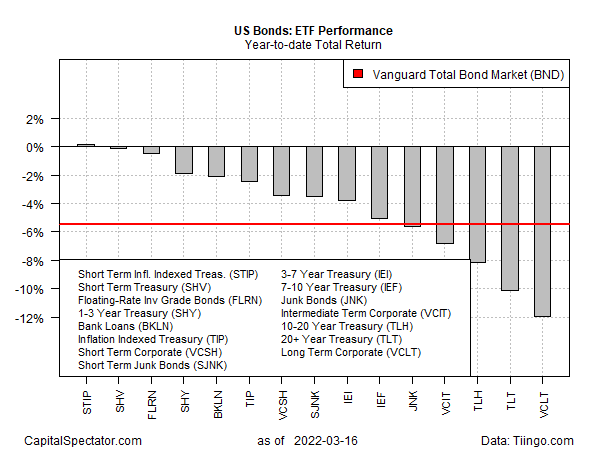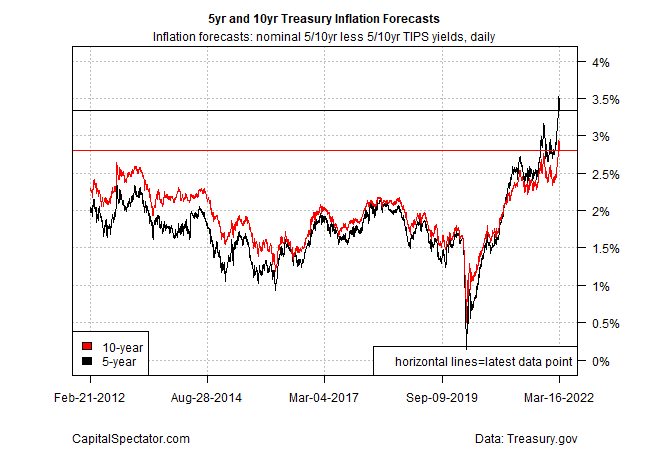The Federal Reserve on Wednesday raised its target interest rate by 0.25 point, the first hike since 2018. The shift in the posture of monetary policy isn’t surprising, given the surge in inflation. Equally unsurprising is the weak performance of fixed-income securities this year, which continue to price in rough times ahead for the asset class overall.
Nearly all flavors of U.S. bond ETFs are currently posting losses for the year to date (through March 16). The declines range from trivial to steep. Only one of the tickers for our set of ETF proxies for the U.S. fixed-income markets is posting a gain in 2022: iShares 0-5 Year TIPS Bond ETF (NYSE:STIP), which holds short-maturity inflation-indexed Treasuries and is up fractionally year to date – roughly 0.2%.

Otherwise, bonds across the spectrum are in the red this year. The deepest decline is in long-term Vanguard Long-Term Corporate Bond Index Fund ETF Shares (NASDAQ:VCLT), which has tumbled 12% year to date.

The question is how long the headwinds will last for the bond market?
Using the Fed’s policy-making committee as a guide, fixed income will be under pressure for the foreseeable future. The Federal Open Market Committee (FOMC) yesterday outlined its current forecast for the Feds fund rate, which edged up to a 0.25%-0.50% range. By the end of the year, the FOMC anticipates Fed funds will rise to 1.9%, based on the committee’s median estimate. By the end of next year, the current forecast sees Fed funds rising to 2.8%.
The expected hikes aren’t written in stone and can be adjusted, based on incoming economic data. But while the exact timing and size of hikes are open to adjustment, the market is now convinced that interest rates overall will move higher in the months ahead, perhaps through 2023 and beyond. In the words of the central bank’s policy statement released on Wednesday, the Fed “anticipates that ongoing increases in the target range will be appropriate.”
For the next Fed meeting (May 4), futures are estimating a near certainty of another hike, with a moderate edge (61% probability) for another 25-basis-point increase vs. a 50-basis-point rise (39% probability).
Fed Chair Jerome Powell left little doubt about the policy outlook. In yesterday’s press conference he said “we are attentive to the risks of further upward pressure on inflation and inflation expectations.” He added that “the committee is determined to take the measures necessary to restore price stability” and that “the U.S. economy is very strong and well-positioned to handle tighter monetary policy.”
The key driver of the policy shift is the recent increase in inflation. Using the Consumer Price Index as a guide, inflation continued to heat up in February, rising 7.9% over the past year – a 40-year high.
The war in Ukraine is expected to keep inflation pressures high and so a peak in pricing pressure doesn’t appear imminent. As long as inflation is running far above the Fed funds target, as it is now, additional rate hikes are likely.
A turning point, or at least a pause, may be signalled when inflation shows signs of peaking. One way to monitor such an event is by watching the Treasury market’s implied inflation forecast, based on the yield spread for nominal less inflation-indexed yields. But as recent changes on this front suggest, the market continues to price in elevated/rising inflation pressures.

What else could change the calculus for the current expected path of interest rates? A sharp slowdown in economic activity or a recession. Although U.S. recession risk is currently low, that could quickly change, some economists predict.
Among the more bearish analysts on the U.S. economy is David Rosenberg, chief economist of Rosenberg Research.
He said:
“The Fed is caught in a box of its own making because it didn’t move quickly enough on raising rates. Now it has to be seen to move aggressively."
As a result, he added:
“I think the recession risk is very high.”
If he’s right, the bond market may be get a break as the crowd’s bias shifts from worrying about inflation to looking for safe havens. That’s a tough way to earn a positive return in fixed income, but for now it may be the only way for bonds to avoid negative results.
